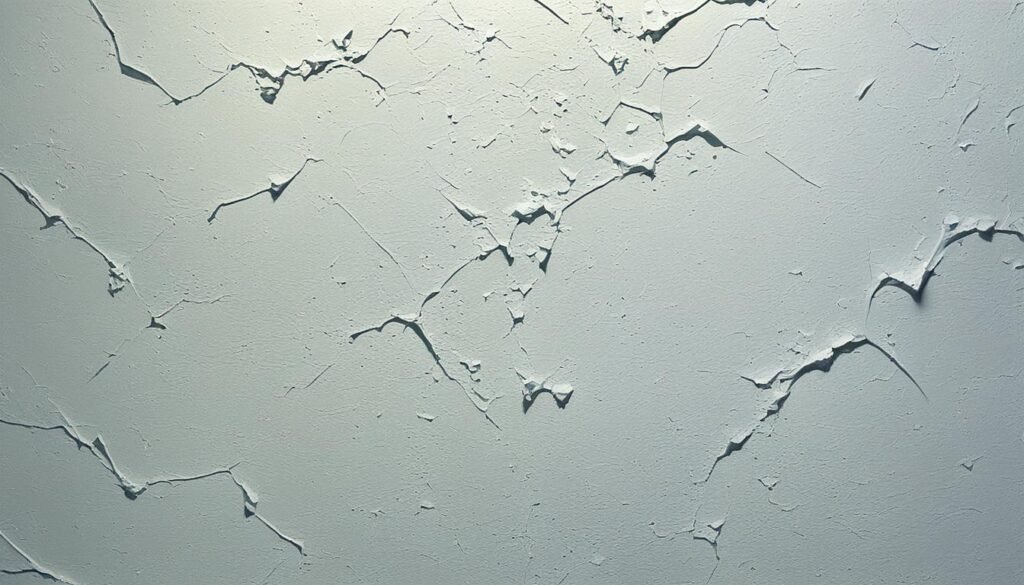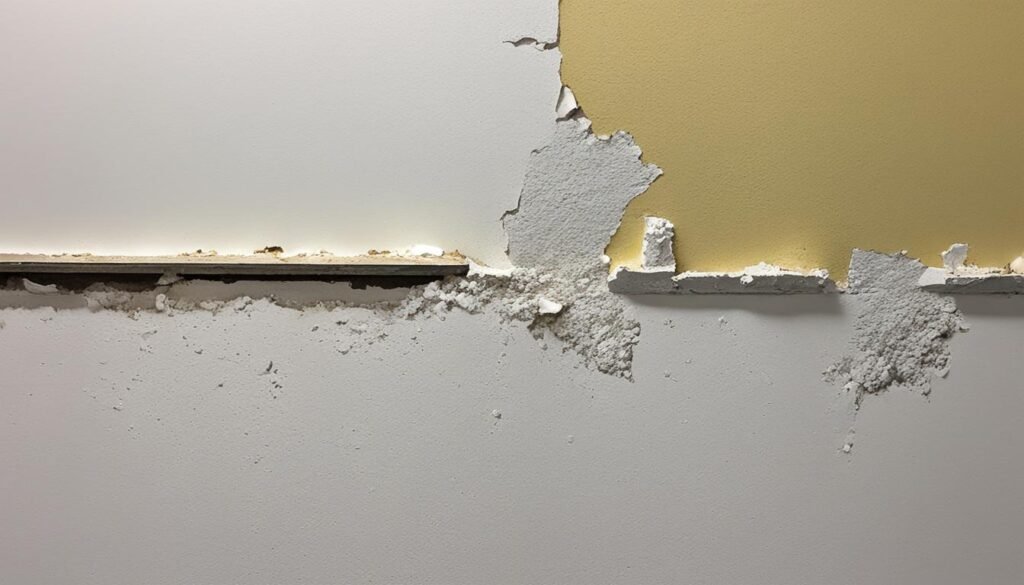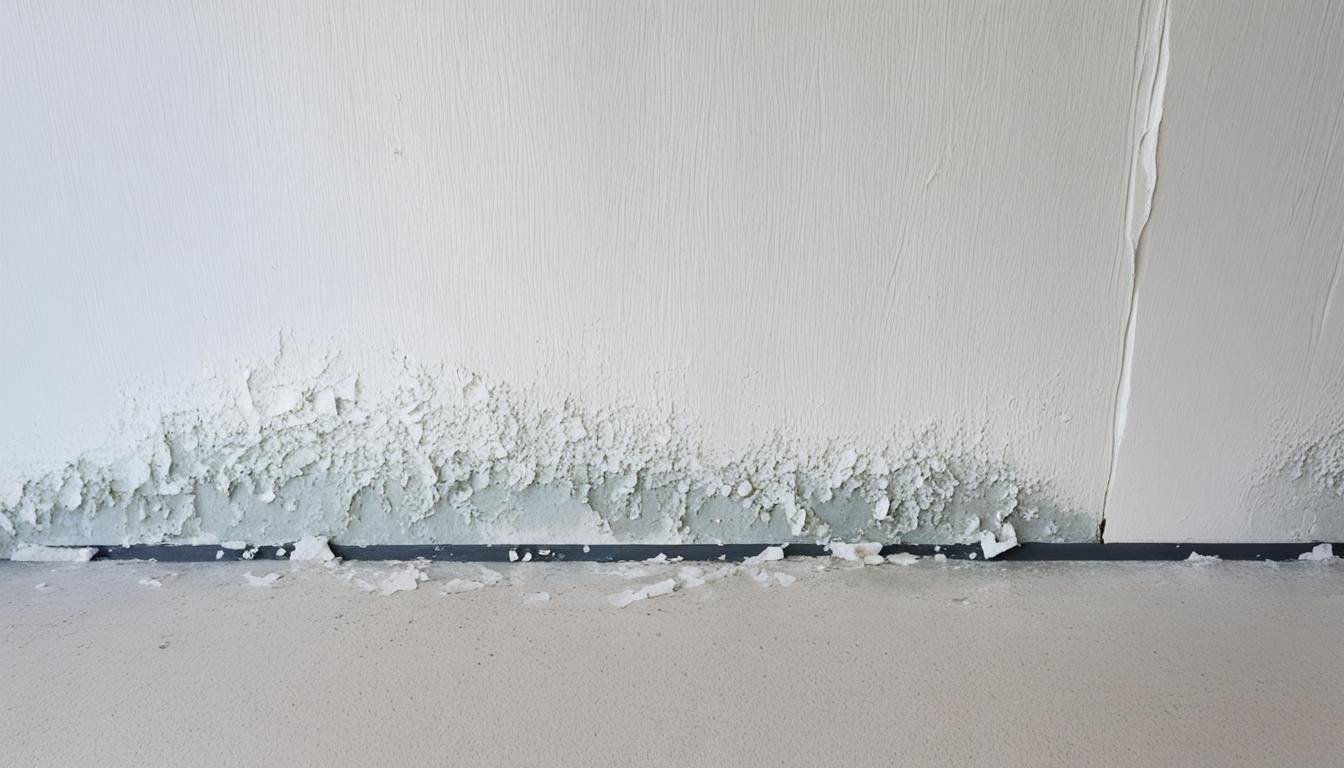Drywall is often hit hard by water, especially the standard type. It’s more likely to get damaged than the types made to resist moisture or mold. When water soaks into drywall, it can cause a lot of problems. These include mold growing and even issues with the building’s structure. But, figuring out if you should replace wet drywall isn’t always easy. This piece looks at what makes the call. Should you take it out, or is there a way to save it with the right drying and fixes?
Key Takeaways
- Drywall is highly susceptible to water damage due to its ability to easily absorb moisture.
- The type of water, duration of exposure, and extent of damage all play a role in determining if wet drywall can be salvaged or needs replacement.
- Mold growth, swelling, warping, and compromised structural integrity are common issues with water-damaged drywall.
- Replacing wet drywall can be a costly endeavor, with material and labor costs ranging from $300 to $400 on average.
- Moisture-resistant or mold-resistant drywall may be a more resilient option in areas prone to water damage.
The Impact of Water on Drywall
Drywall is made of gypsum and paper. It easily gets damaged by water. When it gets wet, the paper and gypsum inside it can fall apart. This leads to many problems, like weak walls.
Mildew and Mold Growth
Water-damaged drywall can quickly grow mildew and mold. The wet environment is perfect for them. They can spread fast and make the air harmful to breathe. This can cause allergies and asthma. It’s important to act fast to stop more mold from growing.
Swelling and Warping
Water makes drywall swell and warp. This can ruin the look of your walls. You might see bumps or parts that look uneven. If you don’t fix it, your walls might not be safe.
Weakened Structural Integrity
The inside of drywall can turn soft if it gets too wet. This makes your walls weaker and more likely to fall. It can also increase how much energy you use at home. Your house might not feel as comfortable.

Water damage to drywall causes many problems. From ugly mold to unsafe walls, it’s a big issue. Quick help from experts is the key to keeping your home or business safe and healthy.
Factors Influencing Salvageability
Water-damaged drywall might be saved or not, based on key factors. Knowing these can guide homeowners and experts in their choices. It’s important to understand what to do.
Type of Water
The water’s type is crucial. Clean water from a pipe issue is easier to handle than dirty flood or sewage water. The latter can be harmful and quickly cause mold, making the drywall unusable.
Duration of Exposure
How long the drywall has been wet is very important. The longer it stays wet, the more damage it can face. Quick reaction and efforts to dry the area can save the drywall.
Extent of Damage
The spread of water damage and how much water got in are big factors. A small wet area is easier to fix than a large soaked one. Different damage levels, from light to heavy, also affect how easily the drywall can be saved.
Type of Drywall
The drywall’s type matters, too. Some types, like those designed to resist moisture or mold, can be easier to save. Knowing the drywall’s kind helps choose the best approach.
Considering these factors helps make smart choices on saving or replacing drywall. It’s crucial to think and act fast to save the drywall and prevent major water damage issues.

| Water Damage Class | Description | Salvageability Potential |
|---|---|---|
| Class 1 | Minimal moisture, affecting a limited area | Highest |
| Class 2 | Larger amount of water, affecting entire rooms | Moderate |
| Class 3 | Greatest amount of water, affecting entire areas | Lower |
| Class 4 | Specialty drying situation, involving materials like stone or concrete | Lowest |
Understanding these factors is key for owners and pros to decide whether to save or replace the drywall. Acting fast and thinking carefully can increase the chance of saving the drywall.
Replacing Wet Drywall: Is It Necessary?
Wet drywall can be a big concern when a home has water damage. Sometimes, you must replace it to keep your place safe and strong. By knowing when to replace wet drywall, you can avoid problems and save money during water damage restoration.
Look for signs like stains, dark marks, or spots where water gathered. If the drywall feels damp, take it out. It must dry completely. But, finding hidden damage or leaks that dried up is harder. You might need drywall repair pros to help.
| Water Damage Category | Drywall Replacement Requirement |
|---|---|
| Category 1 (Clean Water) | Possible, depending on the extent and duration of exposure |
| Category 2 (Greywater) | Likely necessary due to potential contaminants |
| Category 3 (Blackwater) | Definitely necessary due to severe contamination |
The kind of water damage matters a lot. Clean water from Category 1 might just need to be dried and cleaned. But, Category 2 and 3 bring in harmful stuff, so you usually need to replace the drywall. If there’s mold, you must act fast and have a pro check it out.
Deciding on replacing wet drywall is best done with advice from professionals. Pacific Flood Restoration can recommend what’s best for your home. They know how to manage the damage and keep your place sturdy during home renovation.
Conclusion
If your drywall gets wet, it might not need replacing. But deciding can be hard. It’s best to get help from water damage experts, like the folks at Water Damage Pros in San Bernardino (951-903-5429). They can help you understand what’s best for your home.
Are you facing water damage or just trying to keep your house safe? Getting advice from pros can really help. Doing something quickly to fix water damage is crucial. It stops big problems like mold and weak building materials.
It’s serious if your drywall is damaged by water. Getting help from experts, such as Water Damage Pros, is smart. They can help fix the problem, keeping your home strong and your family safe.
FAQ
Is it necessary to replace wet drywall?
How does water damage affect drywall?
What factors determine if wet drywall can be salvaged?
When is it necessary to replace wet drywall?
How can professionals help with water-damaged drywall?
Source Links
- https://mypropainters.com/blog/does-wet-drywall-always-need-to-be-replaced/
- https://trusscore.com/blog/three-signs-you-need-to-replace-your-drywall.html
- https://jenkinsrestorations.com/how-to-tell-if-a-drywall-is-water-damaged/
- https://www.teamgreenclean.com/what-happens-when-drywall-gets-wet-and-what-you-should-do-about-it/
- https://abbottsfireandflood.com/blog/drying-drywall-steps/
- https://www.alldryus.com/blog/water/should-you-replace-drywall-if-it-gets-wet/
- https://damagerestorationexpert.com/does-wet-drywall-always-need-to-be-replaced-2/
- https://www.alorair.com/blog/four-degrees-of-water-damage/
- https://www.servicemasterrestore.com/blog/insurance/factors-that-affect-water-damage-restoration-cost/
- https://rainbowrestores.com/blog/does-wet-drywall-always-need-to-be-replaced
- https://www.pacificflood.com/blog/should-you-replace-drywall-if-it-gets-wet/
- https://www.servicemasterrestore.com/servicemaster-cleaning-and-restoration-mount-sterling/why-us/blog/2020/august/should-you-replace-wet-drywall-/
- https://patchmaster.com/article/moso-what-to-do-when-drywall-gets-wet
- https://www.waterdamagerestorationaz.com/replacing-water-damaged-drywall
- https://dkirestotech.com/why-is-wall-water-damage-restoration-necessary/


